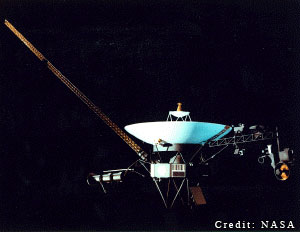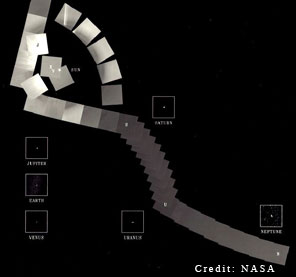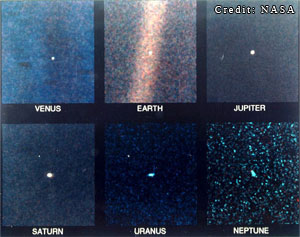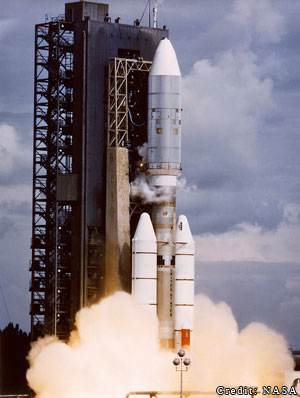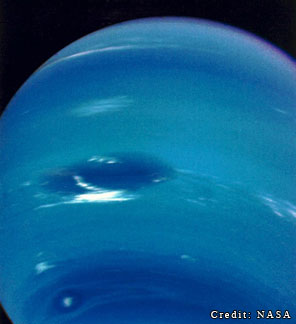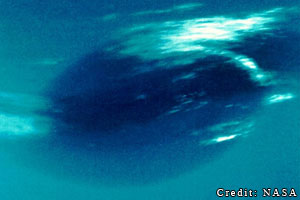
Voyager 1 & 2Voyager 1 & 2
Summary: The Voyager missions were responsible for some amazing discoveries about the outer planets. Voyager 2 sent back the first detailed images of Uranus and Neptune.
Voyager 1
Voyager 2
Results of the Voyager missions
Related links
Related Lessons:
Is There Life on Earth?
Voyager 1
- Launch Date: 5 September 1977
- Mission: Explore Jupiter, Saturn and their satellites
- Arrived at Jupiter: March 1979
- Arrived at Saturn: November 1980
Launched from Kennedy Space Center, Voyager 1 was the first of twin spacecrafts launched in 1977 to reach Jupiter. Voyager 1 set out to collect information on the atmospheres, interiors, satellites and magnetospheres of Jupiter and Saturn. Voyager 1 took roughly 32,000 pictures of Jupiter, Saturn and their moons and rings. When its mission was complete, Voyager 1 remained rather quiet until its cameras were turned back on in early 1990 to take pictures of our solar system. Voyager 1 took some 60 pictures of the Sun and 6 of the planets, the first shots ever taken from "outside" our Solar System. The 60 frames were combined to make the mosaic seen below. The six individual shots on the right were taken when Voyager 1 was more than 4 billion miles from Earth. Earth appears framed in brightness due to the amount of light scattered while taking the picture with Earth so close to the Sun.
FIND OUT MORE AT
THE VOYAGER
HOME PAGE
Capturing shots of the Sun, Venus, Earth, Jupiter, Saturn, Uranus and Neptune was the last of Voyager's tasks and the cameras were once again turned off. Still speeding away from us, Voyager 1 is approaching the outer edge of our Solar System and is currently the most distant man-made object in space.
Voyager 2
- Launch Date: 20 August 1977
- Mission: Explore all of the outer planets and their satellites
- Arrived at Jupiter: July 1979
- Arrived at Saturn: August 1981
- Arrived at Uranus: January 1986
- Arrived at Neptune: August 1989
Even though it arrived at Jupiter 4 months later, Voyager 2 actually left Earth before Voyager 1. Voyager 2's objectives were the same as Voyager 1, and they both ended up collecting about the same number of photographs of Jupiter and Saturn. Despite initial complications with Voyager 2, permission was granted to extend its mission to Uranus, Neptune and beyond.
Successful flybys of Uranus starting in January 1986 allowed for roughly 8,000 images of the planet and its satellites. A few years later, in August 1989, Voyager 2 arrived at Neptune and collected around 10,000 images.
This image of Neptune, taken by Voyager 2, shows the Great Dark Spot. Though comparable in size to the Great Red Spot on Jupiter, it is actually an atmospheric hole kind of like the one in the Earth's ozone layer.
The picture below is a close up of the Great Dark Spot, also taken by Voyager 2.
Results of the Voyager missions
- Discovery of 22 new satellites: 3 at Jupiter, 3 at Saturn, 10 at Uranus, 6 at Neptune
- Discovery of Jupiter's rings, and additional information about the rings of Saturn, Uranus and Neptune
- Discovery of Uranian and Neptunian magnetospheres
- Discovery of active volcanism on Io, and active geyser-like structures on Triton
- Discovery of auroral zones on Jupiter, Saturn and Neptune
The official Voyager missions home page
See more Voyager mission images

